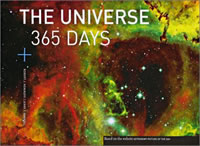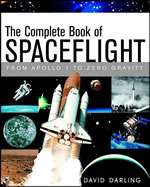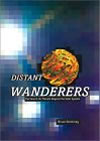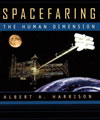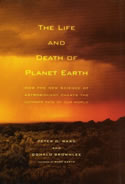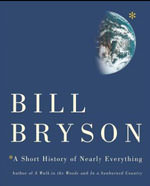
From the instant of the Big Bang to right now, A Short History of Nearly Everything by Bill Bryson chronicles how we ended up where we are – and how we figured it all out.
A Short History of Nearly Everything starts at the beginning, with the Big Bang, but then it starts to jump around following the connections of scientific discovery. For example, Clair Patterson finally discovered the age of the Earth in 1953. He made this discovery by assuming correctly that meteorites were formed at roughly the same time as the Earth, and since they didn’t come from the Earth, they couldn’t be contaminated with local minerals. But he based his discoveries on a technique of radioactive dating and knowledge that meteorites are rocks from space. And each of these discoveries are based on previous discoveries. And so on? and so on. Needless to say, there’s a lot of ground to cover. If you’ve ever seen James Burke’s “Connections”, you’ll have a better understanding of how this book is organized, jumping from concept to concept, stringing together the big picture.
Bryson wrote the book because he found that science textbooks state facts, like the Earth is 4.5 billion years old, but don’t really go into how these discoveries came about. How do we know this? Who were the scientists who made these discoveries in the first place? He set off to answer these questions and soon realized that our understanding of our place in the cosmos is based on a long series of discoveries, accidents, and meticulous research by countless scientists. That’s fine, lots of interconnected people, but what really convinced Bryson to write a 548-page book on the subject, however, is just how interesting some of those people were.
The book pauses on some of the more colourful characters of scientific discovery, such as arch-rival dinosaur hunters Edward Drinker Cope and Othniel Charles Marsh. Their bitter rivalry, which sometimes included throwing rocks at the other team, led to some of the most productive discoveries in paleontology. Or Fritz Zwicky, who coined the term “supernova”, and was notoriously aggressive – he’d drop and do one-armed pushups in front of anyone who didn’t think he was in shape. His own lab partner refused to work in the same room alone with him.
Bryson isn’t a scientist, he’s a writer, but he clearly did his homework over the course of the three years he took to put this book together. The writing is clear, entertaining, and never slips into industry jargon – if anything, Bryson underestimates the reader and explains some concepts a little more than he needs to. And this book is funny. I can’t remember the last time I ever laughed so much reading a book about science.
Bill Bryson sure picked a wide-ranging topic for his first science book, A Short History of Nearly Everything. But I’ve got to say, he really delivers the goods. It’s a great book – one of the most entertaining science books I’ve read in years.
Read more about the book at: Amazon.com – Amazon.ca – Amazon.co.uk

